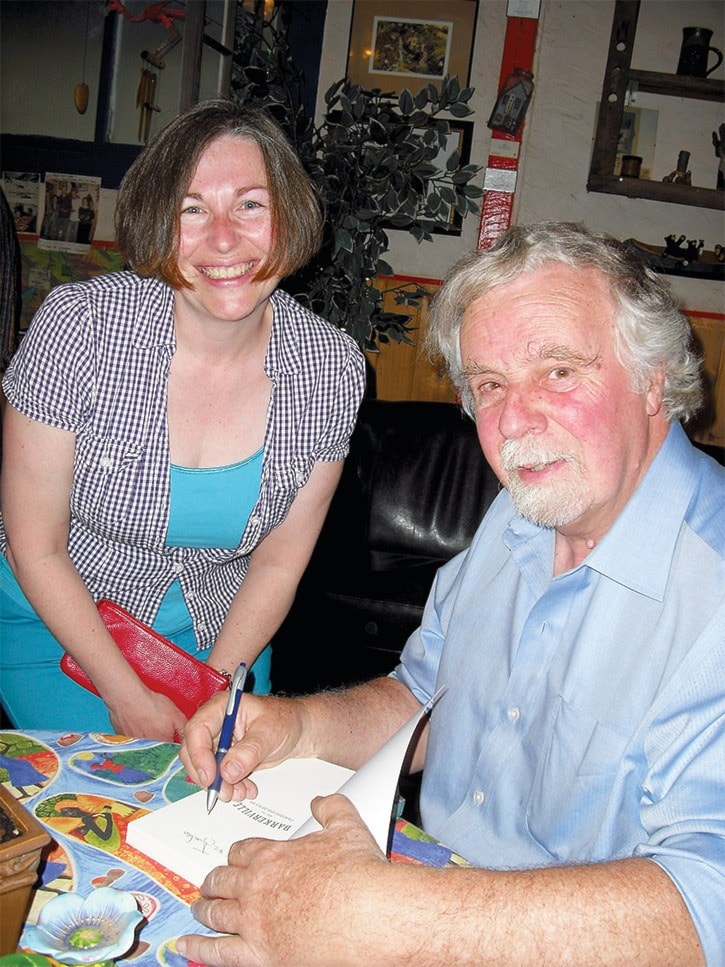Author, historian, impresario and performer, Richard Thomas Wright, came to the Cariboo 30 years ago to write a book on Barkerville.
He completed his task and published four editions of the book and has sold 35,000 copies.
But he says the stories kept on coming and the mystique of Barkerville continued to grow as he and other historians dug up more information.
Now Wright has rewritten the book and with Heritage House Publishing has published the fifth edition of Barkerville and the Cariboo Goldfields this year. It includes new material on all the gold camps and creeks surrounding Barkerville.
“It’s a complete rewrite,” Wright told an enthusiastic audience at his recent book launch in the Bear’s Paw Cafe in Wells. “We keep digging up new information on the gold rush.”
He said one of the newer bits of information is how the characters of Barkerville were actually part of a larger moving social circle of friends and associates who worked the gold rush diggings across North America and as far afield as Australia.
“Barkerville illustrates a specific time and place but there was a deeper gold rush society of moving social entities,” Wright said. “The same people keep showing up in gold rush to gold rush, from Georgia in 1828, to California in 1848, Australia in 1852, the Cariboo in 1859, Omineca in 1871, and the silver strikes in the 1870s in Arizona and Nevada. We found the same people in all these rushes.”
Some of the gold seekers were very good at what they did and prospered because they had the knowledge and capital behind them. Many of the people who made a name for themselves in the Cariboo were familiar faces in other places too. These included Billy Barker, Cariboo Cameron, Wellington Delaney Moses, Madam Fanny Bendixen and William Ross “Doc” Keithley.
“There were 70 people identified as mining or working in California before moving to the Cariboo,” Wright said, explaining how he gleaned his new information from police and court records, census data, newspaper articles, biographies, memoirs and death records.
“A census from Tombstone, Arizona had some of the same names as people in Barkerville.”
One Cariboo court record showed that James McMillan testified in court that he knew Eliza Ord in California 15 years earlier by another name, Mrs. Christian. Similarly David William testified that he knew Mary and Samuel Nathan in Australia in 1852.
Wright pointed out that at least 20 Barkervillians had been in the Australian gold fields, and half a dozen men who found themselves in the Cariboo around the same time, had been in the Royal Engineers together. Another half-dozen had been in the Crimean War and a few had been in India together.
A miner’s notoriety tended to follow him as well. Liverpool Jack was banned from California in 1854 by the Committee of Vigilance and banished to New York, but he returned to the west and ended up in Barkerville where he was widely known as an outlaw and petty criminal.
Outlaw Boon Helm who murdered three merchants near Quesnel Forks, and others in Idaho and Montana, was eventually hanged and buried in Virginia City, Montana.
One of the rumours that Wright’s new edition helps dispel is the number of miners who actually worked the goldfields of Barkerville at the same time.
“There were maybe 6,000 people working the North Slope mines but certainly not 20,000 people that some historians have reported.”
Wright bases his information on the number of mining licenses issued. “The population decreased by ten-fold in the winter.”
Other facts peg the average age of the miner at 33 years old, slightly higher than some earlier estimates, and certainly not the army of 19-year-olds that some people have carelessly tossed out there. In one census only 17 were under the age of 20, and 17 were over the age of 50.
The average goldfield death age was 56, mostly due to mining accidents. The average age of death in British Columbia outside the goldfield at that time was 66-years-old.
The miners had an interesting array of nicknames like Black Jack, Wildgoose Bill, Flapjack Johnny, Wake-up Jake, Cotton-vest Bill, Six-toed Pete, and Bill “Two-man” Brown.
Wright, who manages the Theatre Royal in Barkerville with his partner Amy Newman, had a partisan audience at his Bear’s Paw launch. A high percentage of those soaking up this new information were already fans of Barkerville. About a third of them were tourists eager to learn more about the gold rush town, so it didn’t take much encouragement by the author to have them hanging on to his every word. Wright was obviously speaking to the converted.
You could sense the demon gold fever itself, lurking on the periphery as Wright continued to sow more seeds of curiosity. “The more we travel and do our research, the more we’re convinced there’s a Rosetta Stone somewhere that will explain the whole gold rush era thing,” he stated.
“There are more photos to be found...journals to be discovered ...maybe in Germany.”
Barkerville and the Cariboo Goldfields can be found in bookstores wherever Heritage House books are sold, and if you happen to catch the goldfield bug, don’t be shy to trundle up to Barkerville and meet Richard Thomas Wright in person.
The Theatre Royal show alone is well worth the journey.
